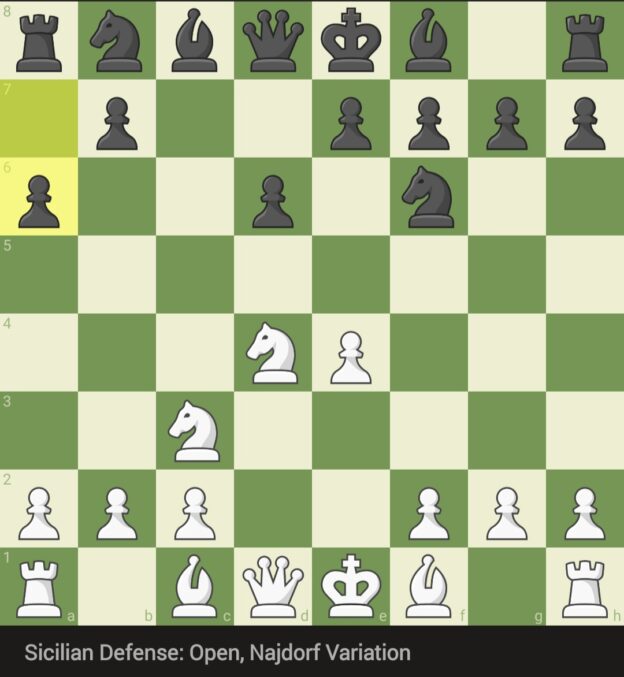Among the pantheon of chess openings, the Sicilian Defense stands as one of the most combative and multifaceted. And within its intricate web, the Najdorf Variation has emerged as one of its most prized jewels. Initiated by the moves 1.e4 c5 2.Nf3 d6 3.d4 cxd4 4.Nxd4 Nf6 5.Nc3 a6, this opening epitomizes dynamic play, rich strategy, and has been a favorite of numerous world champions.
Historical Origins
Named after the Argentine Grandmaster Miguel Najdorf, this variation of the Sicilian Defense gained popularity in the mid-20th century. Najdorf, a charismatic and inventive player, began to champion this line in the 1940s, paving the way for its immense popularity in later years.
Key Strategic Concepts
The move 5…a6, which characterizes the Najdorf, serves multiple strategic purposes:
- Flexibility: The pawn on a6 supports a potential …b5 pawn break, aiming to challenge White’s center and gain space on the queenside.
- e5 Square: Black often seeks to play …e5, kicking the knight on d4, and subsequently placing a knight on e5 or d5, central outposts that offer dynamic play.
- Protection: The a6 pawn can prevent an untimely Nb5 by White, which can sometimes be an annoying incursion.
Main Lines and Evolutions
Given its rich nature, the Najdorf has multiple sub-variations:
- English Attack (Be3, f3, and g4-g5): A direct and aggressive approach by White, aiming for a kingside assault.
- Scheveningen Style (with e6): Black opts for a more solid setup, preparing counterplay in the center or on the queenside.
- 6.Bg5: Pinning the knight on f6 and creating threats on the e4-e5 push.
- 6.Bc4: Eyeing the vulnerable f7 pawn and aiming for a direct kingside attack.
Champions’ Choice
The Najdorf’s dynamism attracted numerous world champions. Bobby Fischer, one of its most famous proponents, utilized the Najdorf to great effect, producing many masterpieces and enhancing its theory. Garry Kasparov, another titan of chess, often employed the Najdorf in crucial games, adding to its rich tapestry of ideas. More recently, players like Maxime Vachier-Lagrave continue to push its boundaries.
Modern Relevance
Despite being heavily analyzed, the Najdorf remains a favorite at all levels. Its depth ensures that even with computer analysis, there are still uncharted territories and novel ideas to be explored. It is a testament to the opening’s richness that it continues to evolve and captivate players after decades of rigorous scrutiny.
In conclusion, the Sicilian Defense, Najdorf Variation, is more than just a sequence of moves; it represents a philosophy of seeking imbalances, embracing complexity, and striving for dynamic play. It is, without doubt, one of the most profound legacies of modern chess, offering players an avenue to express their creativity, courage, and strategic prowess.
